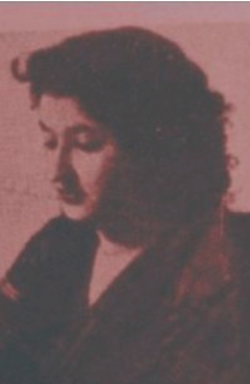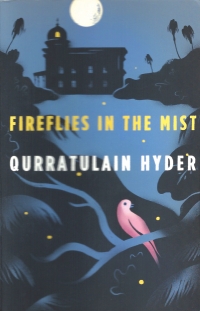| Home - Back Issues - The Team - Contact Us |
 |
| Volume 11 |Issue 43| November 02, 2012 | |
|
|
BOOK REVIEW Fireflies in the Mist Azizul Jalil “Qurratulain Hyder is a wonderful writer. She pairs enormous erudition with a careful eye to detail. Here is one of the most important Indian voices of the twentieth century.”
Manju, mother-in- law of my son, called the other day to ask whether I could lend her 'Fireflies in the Mist' by Qurratulain Hyder. She needed it for her next book club discussion scheduled in ten days time. My quite innocent answer was that I had never ever heard of such a person. Hyder had written about East Bengal and the emergence of Bangladesh among other events in her book. So, Manju assumed that I would surely possess her book. Little did I know then that she was one of the most celebrated Urdu fiction writers, highly acclaimed by Times Literary Supplement, New York Times and by Amitav Ghose. She received the Indian Sahitya Academy Prize, Padma Shri and Jnanpith awards, among other prestigious awards. This essay is a modest attempt by a new admirer of her writings to introduce her to Bangladeshi readers. Ordered through Amazon, the book translated by her from Urdu (Aakher-e-Shab ke Hamsafar) to English arrived in a very short time. Having only time to read the elaborate introduction before urgently giving it to my relative, I went to our Saturday coffee club. When quite out of context, I asked the ten learned members whether they knew of Ms. Hyder. To my pleasant surprise, two of them did. One heard about her and knew that she was very active in PEN literary circles internationally. The other had actually met her at the Saogat office in 1960 when she came to Dhaka to receive its literary award. In less than two minutes of that recollection, he repeatedly stated how exceptionally beautiful she was. Combination of such beauty and intellect is indeed a rarity. The attached picture would adequately testify to that. Born in Allahabad, India in 1927, with her family she migrated to Pakistan at the time of the Partition of India in 1947. Later she went to England to pursue her studies and returned to work in Pakistan for a decade. Her book Aag ka Darya (River of Fire), regarded by many as her best, came out during this period. She had herself translated this book into English. It was not to the liking of the government of Pakistan because of her secular outlook and views questioning the basis for the partition. She could not appreciate the political differences that arose between the Muslim and Hindu communities in pre-partition India after they lived together for centuries and developed a common culture and history. She seemed never reconciled to the idea of the partition and expressed that thought through the fictional characters in the River of Fire. Thereafter, she left Pakistan and settled in India, first in Bombay and then in Delhi. There she worked as one of the editors of the Illustrated Weekly of India and taught Urdu at the Aligarh Muslim University, where her father was the registrar. She died in 2007. She had written 12 novels and novellas including Street Singers of Lucknow, A Season of Betrayals, Sounds of Falling Leaves and Travellers unto the Night. Fireflies in the Mist spans four decades of the history of Bengal, covering the rise of nationalism and the struggle for an independent Bangladesh. According to one reviewer, “Lit by the flare of Hyder's prose, history is captured in the glow of the firefly's wing, unfolding in the lives of her characters as they try to come to terms with their own and Bengal's shifting fortune.” At the center of the novel the reader finds Deepali Sarkar who is attracted to the left wing of the nationalist movement and Raihan Ahmed of Marxist inclinations. In their relationship and doomed love affair, the writer explores the growth of tension between the Hindu and Muslim communities. Aamer Hussein, in his introduction to the Fireflies writes, “It can be seen as another chapter in Hyder's epic history of the Muslim presence in the sub-continent. My Temples Too (Mere Bhi Sanam Khaney) chronicles Awadh; River of Fire takes to newfound Pakistan; Fireflies adds the saga of East Pakistan and Bangladesh.” In the River of Fire there are nuggets of wisdom and discourses on such intellectual subjects like why the East- India in particular, declined and what the causes of the decline of Islam were. Regarding the first question, through her characters she answers that India had an inadequate irrigation system-the problem was purely agricultural. On the second question, the answer attempted was that the rationalists lost out to the traditionalists, who are majority of the Muslims. The latter believed in pre-destination and stuck to a very strict, unchangeable interpretation of the religion.
Through Kamal, she tells that the Mohajirs (refugees) in the mid-nineteen fifties in Karachi were largely from the United Province, forming the bulk of the middle class in the city. They considered India as their home and Pakistan as their country. They would visit their relations left behind in India once every year. Regarding the Urdu language, she laments that in India it was present only in movies and songs produced in Bombay, but presented as Hindi. Otherwise, Urdu was blocked out by the Hindus in India, to whom it is a non-language. The Muslims were demoralised some students graduated in India and moved to Pakistan for better employment opportunities as they thought that even if they took the examination to join the Indian Civil Service, they would not have been selected. Perhaps, things have changed for the better in India in the last half-a-century. In the same book in the chapter on 'The Road to Sylhet', she writes about the beauty and greenery of Bangladesh. Kamal gets a job in East Pakistan and visits Sylhet and Rangamati before going to Dhaka to explore the possibility of setting up a laboratory. Her description of his journey by train to Sylhet is vivid and poetic. She writes about the typical garam chaye and hot boiled eggs being loudly hawed about on the platforms of the wayside rail stations. At one stage of Kamal's journey, he hires a nauka (boat) 'In this fantastic, beautiful land called East Bengal, Pakistan.' He looks around at the streak of bright yellow extended over the dark river waters. A big sampan sails past majestically, as the moon rises slowly behind the willows. I cannot read Urdu and am not a student of literature. So far I have read only two of her books in English. Based on that limited acquaintance I have been impressed by Hyder's story-telling style, feeling she puts into her writing, vivid descriptions and mastery over the English language. How wonderful the stories in their original Urdu must be! I am not aware that short visits apart, Hyder ever lived in either part of Bengal, west or east. Yet her knowledge of the history and geography of East Bengal really amazes me. She writes of East Bengal in an involved and poetic manner as if she was a native of the land. Highly impressed by East Bengal's natural beauty, she writes about 'The songs of the boatmen on the Padma and the romance of Bengal caught in the silvery thread of a fisherman's net.' A great writer, Hyder has been compared with noble laureate Gabriel Garcia Marquez in the Times Literary Supplement and as such, deserves to be read. But for Bangladeshis, reading her works would be particularly rewarding because of her drawing of the rich, scenic images of this country. |
||||||
Copyright
(R) thedailystar.net 2012 |

